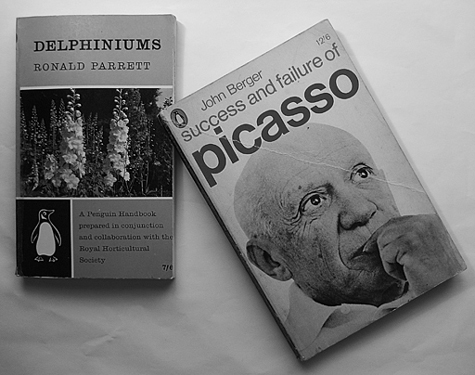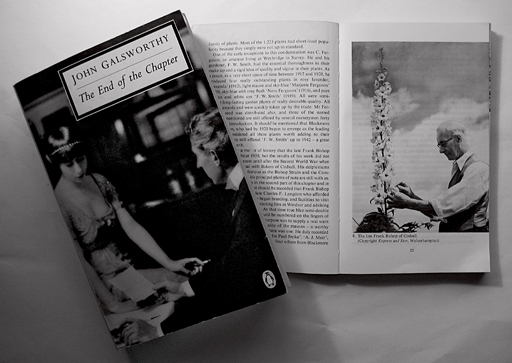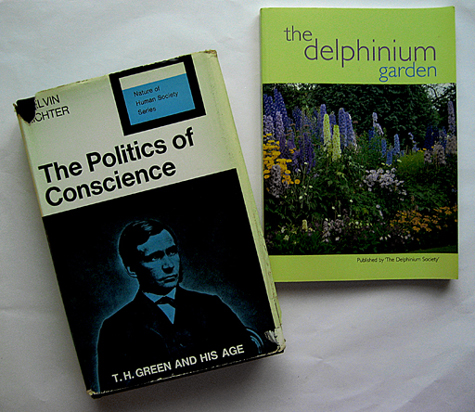Human Flower Project
Razing Delphiniums
The garden one once almost had will grow from seed and history—or it won’t. Let there be difficulty!

“They need sun…they need elbow room…”
Photo: By John Levett
By John Levett
I’ll start with the exciting bit.
S. Victoria x Bruce; Blue D (dark eye) x Galileo; Blackberry Ice x Deep Pink sdg.
I’ll now write a few more paragraphs and allow time for recovery.It was my mother who led me into gardening when I was a child. I took a break from it for about twenty-five years and then returned. Gardening was never mooch-and-potter for me; it was challenge. Find the most difficult to grow; find that which has never been raised in the northern hemisphere; embrace the impossible; raise the unimaginable; defy genetics; restructure creation. In a plot the size of a decent living room.
Cacti & alpines featured heavily. It wasn’t simply the demands of raising things requiring more than dig-and-drop but rather the prospect of the results—horticultural Fabergé eggs. Never mind that the sun never travelled in the right direction, nor that ventilation was practically absent beyond the leaks in the ill-fitting greenhouse door, nor that the heating from the paraffin stove necessary for their geranium housemates during the winter was close to guaranteed to asphyxiate the living planet—the bloom was the prize.
I bought in plants (cacti from market stalls and alpines from Ingwersen’s) but raising from seed was the test. I can’t remember one that survived longer than life in the seed pan. Never mind. (“Try again. Fail again. Fail better.”) Try another plant. Try sweet peas. Sweet peas worked. I bought seed every Autumn from Bolton’s near Haverhill in Essex, usually about ten varieties. I had a 1930s booklet on the raising of sweet peas (all the illustrations in black and white) and followed it to the letter—the seed soaking, the earthenware pots, the measured depth, the sinking of the pot, the ash covering.
Bingo! Enough plants to run a stall. I’d just acquired an allotment so I ditched the veg apart from onions & shallots (alleged to spirit away all manner of nasties) and raised the stakes. I took handfuls back home each evening throughout each summer. I’d found a seed I could handle.
I then discovered the Chiltern Seeds catalogue: a goldmine for the sower and a money-pit too. Go through your initial tick-off list of all you’re going to raise next year, tot up the total and seek a second mortgage on the loan. It never stopped me. Campanulas followed the sweet peas, then hardy geraniums, then species pelargoniums, then pansies and violas. Then the Annual Hitchin Horticultural Show.
I went along to the Summer show the year that I moved to Hitchin, 1972. The following year I started exhibiting my pansies, scooped third prize, headed for the top. Delphiniums arrived in the back garden. It might have been that I saw them at the show but more likely my enthusiasm came from Ronald Parrett’s Penguin handbook. I began collecting those handbooks around that time—The Cool Greenhouse, Rock Gardens, Chrysanthemums (I had a fleeting flirtation with these; grief knows why), Dahlias (ditto) and Roses—Delphiniums is the only one I went through cover-to-cover (again, everything in stunning grayscale).

Ronald Parrett’s delphinium handbook: prelude to failure and success
Photo: John Levett
I bought in some delphinium plants but all failed (one failure I put down to the nursery but if all fail I put it down to me) so I took to raising everything from seed. Between 1975 and 1982 I won the Delphinium Medal at every Hitchin Show and following my final year a request to film my garden. Heady days. My garden was limited, my allotment full. I began outsourcing—aunts, uncles and cousins took seedlings and reported back. So did work colleagues. My lawn began to shrink.
Early on I joined the Delphinium Society and met up with the (I think) secretary; Colin Edwards is the name that comes to mind. He lived in Buckinghamshire and I recall visiting his garden a number of times for advice on cuttings. He never stinted on the time he gave me and I never failed to ignore it. I guess it wasn’t more of the same plant I’d already got but the new and unique that drew me. And then I dropped out of life and gardening for a bit.
Once I’d arrived in a new town and new garden I got back into old habits—fill the plot with roses and then fill in the bits between. Back to old habits—alpines and cacti, campanulas and violas, delphiniums. I got back Ronald Parrett’s handbook, rejoined The Delphinium Society, bought in seed. But I have no delphiniums in my garden.
I could go back to buying in plants. Too easy; I’m still up for the seed challenge. But there’s more to it than that and I think it has something to do with my gardening mind.

Frank Bishop, nurseryman, who enhanced delphinium blue and vigour
Photo: John Levett
I’ve got in front of me a photograph of Frank Bishop. Frank was a nurseryman who worked for the firm of Bakers in Codsall in the English West Midlands where he developed a breeding programme to enhance the quality of blues in the delphinium as well as much that enhanced their vigour and resistance to disease. That’s by-the-bye; what draws me is the picture of Frank, every bit the English gardener. He could be in his own back garden—silver-haired, bespeckled, open necked, waistcoated (that waistcoat containing all the gubbins for cutting, trimming, dibbing, pollinating, tying, labelling) and appearing to take all the time he needed out of all the time he had. Unhurried, careful in all details, carrying his knowledge lightly but informed by knowing that knowledge is still to be got. Never read into a photograph more than is there but it’s rarely possible not to. I look at this photograph taken I-know-not-when but as I look at it I can imagine that at that moment Harold Larwood is running up to bowl at Bill Woodfull at the Adelaide Oval, Hyperion was galloping across Epsom Downs and George Orwell was down and out in Paris, London or Wigan Pier.
What has always attracted me to gardening is not what it is now but what it used to be. It’s almost like cramming a shelf with history books; something that comes naturally. In the garden I want the same. Whenever I’ve chosen to grow something I want to buy into the history of it. Forsaking the most recent disease-resistant, frost-impervious, floriferous-added, colour-enhanced variety I’d take the throw-back lifted from the recently-unearthed back-yard of an imaginary Bert Gubbins (1868-1937) of Cheshunt for no other reason than that William Paul grew up in his parents’ rose nursery in the same town. I could live with a garden of the Reverend Pemberton’s Hybrid Musks. Some would question if Hybrid Musk was in fact a genuine class and Jack Harkness was one who did. But Jack wrote: “The impression one receives of Pemberton from reading him, and about him, is of an eager but practical enthusiast, sometimes too hasty in his reactions, insistent upon achieving his object despite opposition, a slightly Gallic individual with English style.” I’d demur over ‘slightly Gallic’ but otherwise my kind of guy.
If I bought in a delphinium then I’d go looking for Frank Bishop’s left-overs. Eager, hasty, insistent upon achieving my objective despite opposition. Unfortunately such qualities don’t always fit with desired results. I think I’m looking for the garden I almost once had. When I came into my present garden I knew how it would be—roses of every historical period, as many as would fit. I got what I planned & then looked for the spaces. Irises went in—not modern hybrids but those of ‘40s & ‘50s vintage. I installed a potting shed, bought staging, said I’ll buy alpines. Only Ingwersen’s would do. I took my last visit before it shut down for good; a brilliant early April Saturday morning motoring down from Cambridge to the Sussex Weald. A year later to a nursery in the Fens for geraniums. Chiltern seeds got my order for allium & poppy; Potterton & Martin (as it then was) got one for galanthus. Beth Chatto’s got a call; so too did Sissinghurst and Harlow Carr. Everywhere I’d been to build my first garden I went back to for my next.

“Whenever I’ve chosen to grow something I want to buy into the history of it”
Photo: John Levett
I got everything that gave me an historical resonance—either mine or gardening’s. I got what I wanted and got what I half-expected. The aspect can’t take it all. The irises don’t get the winter sun; the alpines don’t get the air circulation; the hardy geraniums are overpowered by shade; the clematis climb but are too exhausted to bloom once they reach the forest ceiling. Ferns & hellebores are in their prime and the allium colonise every unwatched patch but the garden museum of hopeful planning (if planning is appropriate for the result) is struggling.
So too have been the delphiniums. I’ve been sowing since 2004; some took, some flowered but it was them against the encroachments. They need sun and they don’t get a season’s worth; they need elbow-room but the climbers climb so far and then drape, gracefully, but too close to the lengthening spikes—razing not raising delphiniums.

Delphinium seed-in-waiting: bring on the books, the difficulty
Photo: John Levett
And so back to S. Victoria x Bruce; Blue D (dark eye) x Galileo; Blackberry Ice x Deep Pink sdg. The seeds are in the fridge in the recommended air-tight container. I’ll go back to the books and do everything by them; everything sterilized; everything monitored; the best of intention and attention given. I’ll raise new plants, provide after-care and, in parallel, start the difficult bit.
I can’t relocate and I can’t move the next-door warehouse but I’ve got agreement to prune next door’s trees. Next I need to cull the roses. Some will have to go elsewhere—maybe to my neighbour, maybe I can dig out a space in front of my flat. I love the enclosure that my garden gives; I built it for that and I don’t need to lose it. But the delphiniums are my test. If I can get them to former glories then I’ve made a step. My aspirations are still for the estate; I’m starting to plan for the handkerchief.

